Posting top-notch content that your audience can connect with should always be your first priority for Instagram growth. But when you feel like you’ve got that down pat, is there anything else you can do to boost your content performance?
As it turns out, there might be.
We dug into Buffer’s rich Instagram data to answer a big question: What’s the ideal posting frequency for growth on Instagram in 2025?
We analyzed over 2 million posts from 100,000+ Instagram accounts — and the data paints a really clear picture: the more you post, the better your content performs.
Technically, this is not news. At Buffer, we bang on about consistently posting a lot. So do plenty of successful creators and, even Instagram’s top boss, Adam Mosseri.
But what does ‘consistency’ actually mean? How often should you be posting on Instagram? How much is too much?
You want specifics? We have them.
Let’s explore what the data says about Instagram posting frequency’s effect on follower growth, reach, and more.
Jump to a section:
How often should you post on Instagram?
Buffer data shows that posting 3-5 times per week on Instagram is likely the sweet spot for achieving both reach and growth without burning out or sacrificing quality.
Posting more frequently than this will lead to more reach and followers, but the returns are diminishing.
⚡️ Posting between 3 and 5 times weekly can more than double follower growth rate, compared to posting one or two times weekly.
✨ Posting 3–5 times weekly could boost your reach per post by around 12% compared to your baseline.
In this analysis, we looked at Instagram feed posts — so photos, reels, and carousels — not Instagram Stories, since stories aren’t ideal for reaching new audiences. More on this below.
That said, if you’re a full-time creator or Instagram-focused brand (and you can do so without sacrificing content quality), you could bump that number up to 6-9 or 10+ posts weekly for a follower boost.
Our analysis shows that posting 6–9 times per week could yield nearly 3.7× the increase in follower growth rate (0.44%) of posting 1–2 times per week.
Posting 10 or more times per week could mean about a 5.5× increase (0.66%).
More growth, yes, there are those diminishing returns we talked about.
The biggest jump in reach per post happens when you move from 1–2 to 3–5 posts per week — about a 12% lift.
Increasing beyond that still drives gains, but the size of each step up gets smaller: 6–9 posts/week adds another ~6 percentage points, and 10+ posts/week adds ~5 more.
On the opposite end of the spectrum, the minimum amount to post on Instagram is 1-2 times per week. Posting any less than that could result in account stagnation or even a drop in followers.
Our recommendations in a nutshell:
- 🌱 If you just want to stay active or maintain your account: 1–2 posts/week
- 🪴 Grow your audience in a sustainable way: 3–5 posts/week
- 🌳 Maximize your growth (treat with caution): 6–9+ posts/week
Does posting more often hurt reach?
Not at all. In fact, the data shows that reach per post actually goes up with more frequent posting.
It is a fair concern — you might be looking at the numbers above, thinking you’d be flooding your followers’ feeds with that much content. Will more posts just cannibalize each other? Or will they annoy your audience, prompting them to unfollow?
Neither of these is likely. Remember how much the various Instagram algorithms and feeds have changed. The home feed, where your current followers will most likely come across your content, hasn’t been chronological for years. It’s unlikely the algorithm will push all your posts out one after the other (it’s much smarter than that!).
I always like to think of adding more posts to my content calendar like buying more lottery tickets — the more you buy, the more likely you are to hit the jackpot of landing on the explore page or reels feed.
Yes, there are diminishing returns at the higher end — but even those extra few posts can move the needle if you have the bandwidth.
Here for the data deep dive? Here are the numbers that back these recommendations up.
📚 The study 📚
How posting frequency affects growth on Instagram
This probably won’t surprise any veteran Instagram creators: The more you post, the more likely you are to reach new people and grow your audience.
Buffer’s resident data scientist Julian Winternheimer sliced and diced the data several different ways, and no matter which angle you take, a higher posting frequency means more reach and growth.
There’s some nuance here, of course — we’ll dig into that below, too.
Before we get into it: In this analysis, we looked at Instagram feed posts — so photos, reels, and carousels — not Instagram Stories.
Since stories are not typically shown to non-followers, they’re wonderful for engaging current fans, but not a game-changer for growing your account.
With that in mind, Julian analyzed the performance and posting frequency of 2.1 million posts from 102K Instagram accounts. He classed posting frequency into five different ‘buckets ’:
- No posts
- 1-2 posts per week
- 3-5 posts per week
- 6-9 posts per week
- 10+ posts
In this study, we didn’t segment reels, single-photo posts, and carousels. All three of these formats are included. (We’re working on it, though, so watch this space for more!)
Here’s what he uncovered.
1. More posts per week means more growth
First, we explored the link between posting frequency and growth, which, as Julian puts it, “shows a strong positive correlation.”
As cool as this is to see, take this analysis with a pinch of salt. “This relationship is nice to see, but it may not tell us the full story,” Julian says. “We need to control for differences in accounts’ natural growth rates.”
The simple (can we call it simple..?) calculation doesn’t account for the differences in the natural growth of large accounts versus small ones. Larger accounts that grow faster might naturally post more.
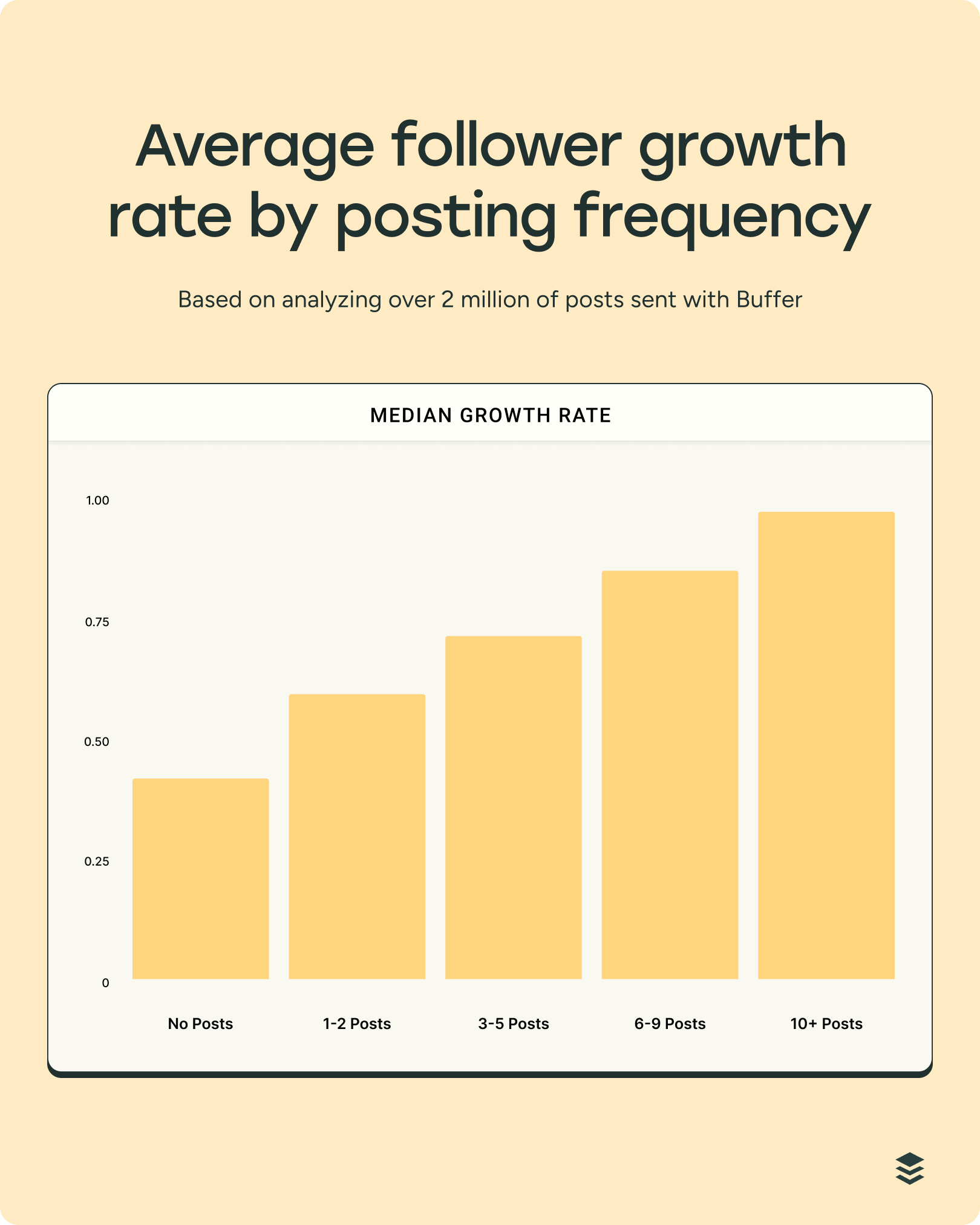
“For example, imagine a fast-growing account that gains 1,000 followers per week and posts 20 times, while a smaller account gains 10 followers per week and only posts twice,” Julian explains.
“If we simply average these together, we might conclude that posting 20 times leads to fast growth. However, the larger account would likely gain a higher number of followers even if they posted less frequently.”
So, without accounting for these differences in accounts, we can’t tell whether frequent posting causes growth, or whether naturally fast-growing accounts just happen to post more.
To confirm the correlation between posting frequency and growth, Julian did the slicing and dicing I mentioned.
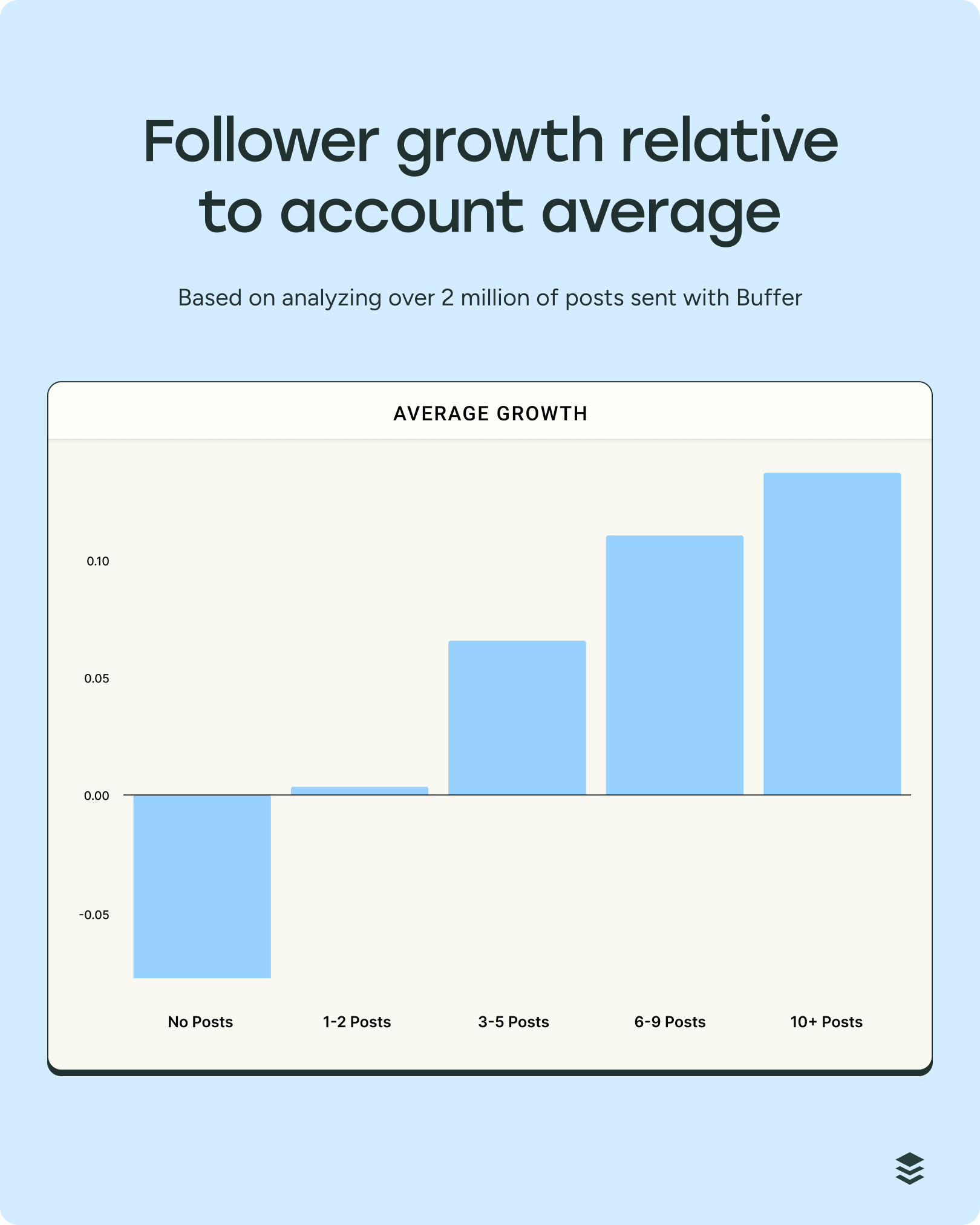
Instead of comparing different accounts, this method (called a z-score analysis) compares each account to its own baseline level of growth. So, essentially comparing each account to itself.
- For each account, we calculated their average follower growth rate across all weeks, and how much that number tends to vary (i.e., their standard deviation).
- Then we looked at how each individual week compared to that average.
Here’s the data presented another way:
And how we defined these Z-scores:
- Z = 0: Typical performance for this channel
- Z = +1: Strong positive week (better than ~84% of weeks)
- Z = +2: Exceptional week (better than ~97% of weeks)
- Z = -1: Poor week (worse than ~84% of weeks)
“This data suggests that there is a strong positive relationship between posting frequency and follower growth on Instagram,” Julian says. “Channels that post more frequently consistently gain more Instagram followers relative to their baseline.”
2. Not posting at all could mean a loss of followers
You may have already spotted this — but take a look at the ‘No posts’ bar again. The analysis above also shows there is a cost to not posting.
Julian has dubbed this the “no-post penalty”.
On average, weeks with zero posts had follower growth that was ~0.08 standard deviations below the account’s typical growth.
In plain English, that might mean account stagnation, or even follower loss. As an Instagram creator, I can personally attest to the fact that no-content weeks — especially consecutive ones — could result in a slow, steady decline in followers.
“Channels that don’t post at all significantly under-perform their baseline growth rates,” Julian says. “Even posting once or twice a week results in a significant increase in follower growth compared to weeks with no posts.”
3. Consistent posting drives real, measurable growth
In another analysis, Julian explored how much posting frequency can impact growth, compared to weeks when users don’t post at all.
Like the Z-score model, the fixed-effects model also compares each account to itself, but instead of examining individual weeks, it focuses on isolating the effect of posting more or less.
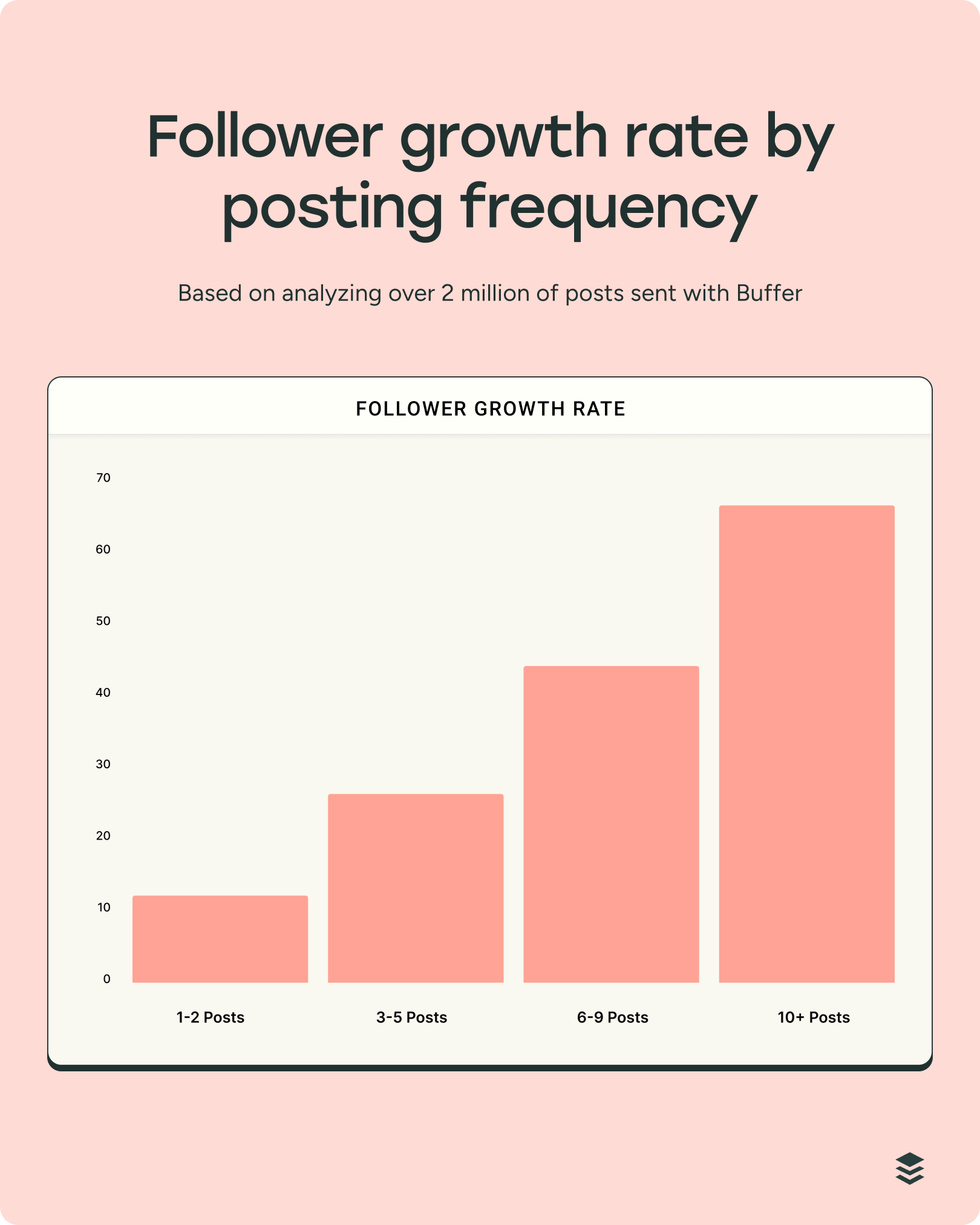
It controls for each account’s unique baseline and long-term behavior, then it measures whether follower growth goes up during weeks when that same account posts more often.
It confirms the same story:
- 1–2 posts per week: +0.12% follower growth rate
- 3–5 posts per week: +0.26% follower growth rate
- 6–9 posts per week: +0.44% follower growth rate
- 10+ posts per week: +0.66% follower growth rate
Note that we’re talking about an increase in follower growth rate, rather than % increase in total followers. Here’s a practical example:
I have 5K followers on Instagram. For simplicity's sake, let’s assume that when I don’t post at all, my account remains stagnant (my baseline growth rate is 0%).
- Posting 1–2 times/week could mean about 6 more followers per week than not posting at all.
- Posting 3–5 times/week could add about 13 more followers/week.
- Posting 6–9 times/week could mean 22 more followers/week.
- Posting 10+ times/week could mean 33 more followers/week.
The example above is also a really clear way to look at the diminishing returns of posting more than five times per week. I usually post once per week, so adding two more posts to my content calendar would probably net me around 13 more followers. Great! Two more posts aren’t a huge lift.
But to move myself up into the next category (and only gain 9 more followers, compared to the previous jump) I’d need to double the amount of extra posts I’m creating. More followers, yes, but I don’t have the bandwidth to create six Instagram posts every week — much less six good posts.
Armed with this data, I’ll happily bump my frequency up to 3 posts per week for a much more sustainable increase I can maintain long-term, without sacrificing the quality of my content.
4. Posting more consistently increases weekly reach
Here’s another finding that wasn’t surprising, given that reach and follower growth tend to go hand in hand.
The more you post in any given week, the higher your reach for the week will be.
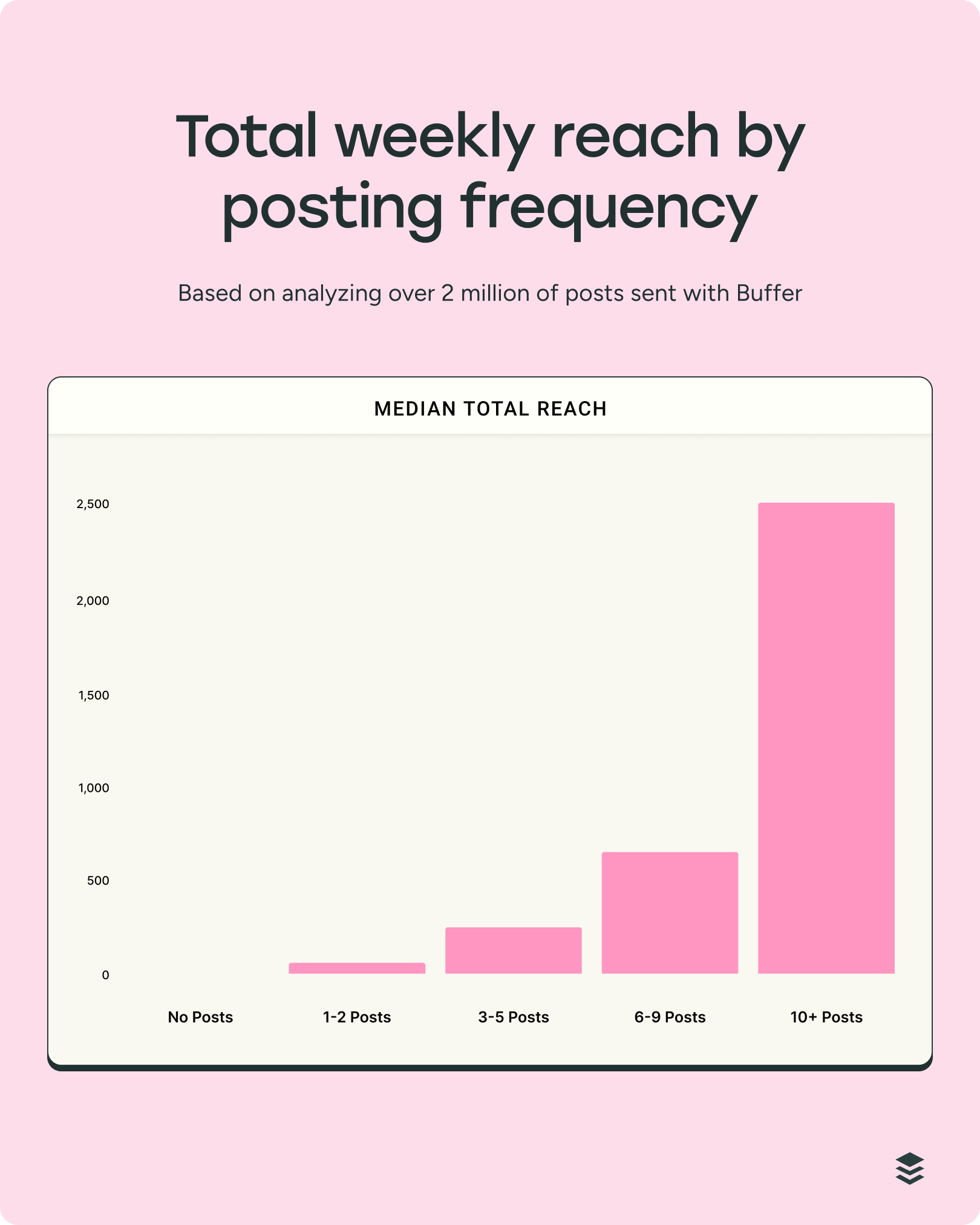
That’s pretty common sense — the more you post, the more opportunities you have for appearing in your followers’ home feeds, the reels feed, or even the explore page.
But here’s where things get interesting...
5. Posting more means more reach per post
We analyzed median reach per post, and found that accounts that post more tend to get more views on every piece of content.
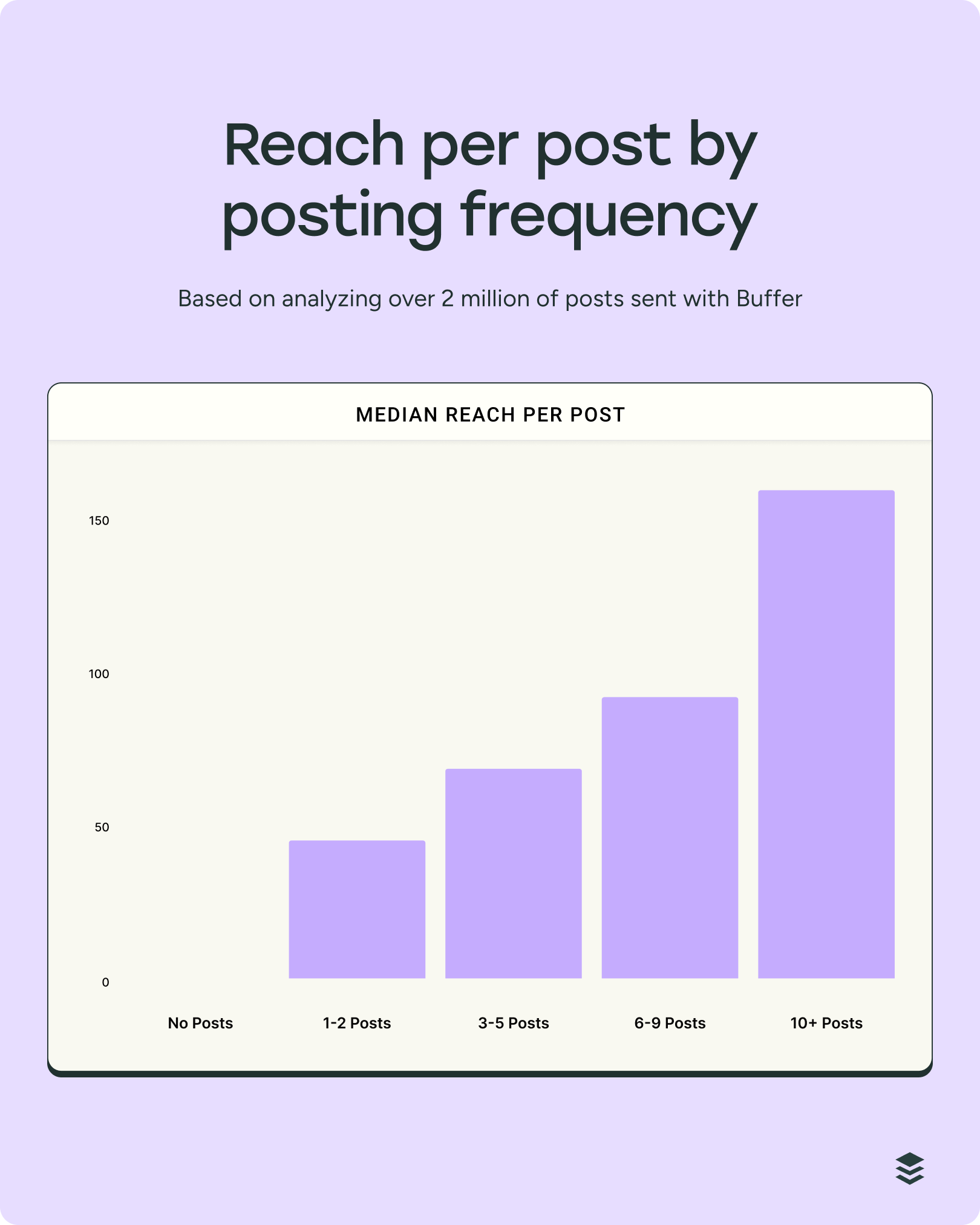
“Each step up in posting frequency delivers substantial percentage gains in reach per post,” Julian says. “The largest jump occurs when moving from 1-2 to 3-5 posts.”
Compared to posting just 1–2 times per week:
- Posting 3–5 posts/week = ~12% more reach per post
- Posting 6–9 posts/week = ~18% more reach per post
- Posting 10+ posts/week = ~24% more reach per post
This is a pretty clear signal that the Instagram algorithm rewards consistency.
“Even at higher frequencies, there are still meaningful 20-25% incremental gains for posting more frequently, however the returns are diminishing.”
More diminishing returns here? Yep. As Julian pointed out, the biggest jump happens when you move from 1–2 to 3–5 posts per week. With each frequency jump, the reach gain shrinks every time.
So, what does all this mean for creators and brands looking to grow on Instagram?
The tempting conclusion is that posting more than 10 times per week on Instagram is the fastest way to increase reach and growth.
Technically speaking, it is. But creating more than 10 posts on Instagram per week might mean:
- You have to drop the quality of your content in order to produce at that volume
- Burnout — so you quit posting altogether after two or three weeks.
Both of these things might prove more detrimental to your overall follower growth than taking a more measured approach.
More does not always mean better
The best posting schedule is one you can stick to consistently.
“For me, the bottom line is that Instagram rewards frequent and consistent content creation,” Julian says. “However, there is a big caveat that the most important factor probably remains content quality. You’re probably not going to see big gains in followers and reach by pumping out low-quality posts.”
Posting frequency is one of the most powerful levers you can pull to grow on Instagram, and the numbers back that up. But remember: quality matters, and burnout is real.
Focus on consistent, sustainable effort over short bursts of high volume. Even small increases in how often you post can make a big difference.
More Instagram resources
Try Buffer for free
190,000+ creators, small businesses, and marketers use Buffer to grow their audiences every month.




